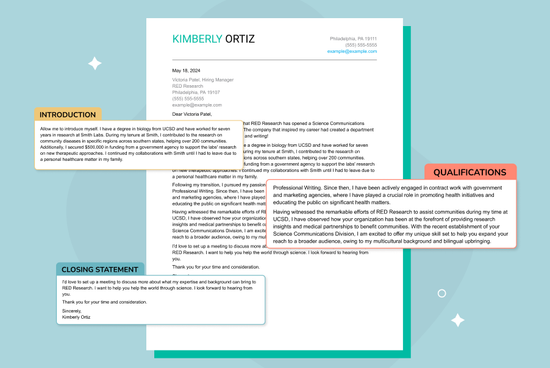Our customers have been hired at: *Foot Note
A well-crafted letter of intent (LOI) is a powerful tool for articulating how your passion and qualifications align with a company’s values and goals.
If you are interested in a company that does not have a specific job opening advertised, you can use a letter of intent to introduce yourself and express your interest in working for them.
In this guide, we’ll discuss when and how to write a letter of intent. Browse professionall crafted letter of intent examples and use our Cover Letter Generator to craft your own in a matter of minutes.
Make a cover letter with MyPerfectResume
Our Cover letter builder can help you write the perfect cover letter. Start Now!
What is a letter of intent?
A letter of intent, also known as a letter of interest, expresses your desire to work for a particular company and provides an overview of your professional accomplishments.
Although similar to a cover letter in terms of formatting and structure, a letter of intent serves a distinct purpose that differs from the standard job application cover letter.
A letter of intent for a job is typically used in the following scenarios:
- Initiating contact with a company: If you are interested in working for a specific company that does not have active job listings that fit your criteria, you can write a letter of intent expressing why you are interested and what value you can offer.
- Connecting with recruiters: After a networking event or job fair, sending a letter of intent can reinforce your interest and reiterate your qualifications. It's a proactive way to keep yourself in the employer's mind as they make their hiring decisions.
- Sending if requested by an employer: Employers might request a letter of intent for a non-specific or project-based job opening. This is most common with nonprofits or startups looking to identify applicants with a passion for the organization’s mission.
We recommend using our Resume Builder to quickly and easily craft a resume that showcases your unique skills and qualifications.
How is a letter of intent different from a cover letter?
A letter of intent and a cover letter are distinct documents sent by job seekers to express interest in employment at a particular company.
Both documents use a cover letter format — the business letter format — and showcase how your skills and qualifications fit the needs of the company.
However, a cover letter is used to complement your resume when applying for a specific role, whereas a letter of intent focuses more on your general interest in a specific company.
Letter of intent vs cover letter
| Letter of Intent | Cover Letter | |
| Business-letter format | X | X |
| Job-specific | X | |
| Company-specific | X | |
| Professional skills | X | X |
| Career accomplishments | X | X |
| One-page letter | X | X |
| Time-sensitive | X |
Letters of intent are a helpful tool when you have the skills and experience that could help a company succeed, even if they don’t have a position that fits at that precise moment.
Let’s say there are two job seekers, both software product managers interested in the healthcare industry. One applies to an open position, and the other expresses interest through a letter of intent.
Letter of intent sample
Dear [Employer's Name],
I am writing to express my strong interest in contributing to [Company Name] as a Software Product Manager. With a career dedicated to software product development and management in the healthcare sector, I am enthusiastic about the prospect of leveraging my skills and experience to support your team's mission.
Throughout my career, I have demonstrated a deep understanding of healthcare software solutions, having successfully led initiatives that have enhanced patient care and operational efficiency. I am particularly drawn to [Company Name]'s reputation for innovation and its commitment to delivering solutions that make a meaningful impact in healthcare delivery.
My approach to product management emphasizes collaboration, strategic vision, and a keen understanding of market dynamics. I am confident that my background in agile development, stakeholder engagement, and regulatory compliance will align well with [Company Name]'s objectives and contribute to its continued success.
I would welcome the opportunity to discuss how my skills and insights could support [Company Name]'s goals. Thank you for considering my letter of intent. I look forward to the possibility of contributing to your esteemed organization.
Warm regards,
[Your Name]Expresses general interest in working for the company and contributing to its goals while emphasizing the candidate's skills and experiences.
Cover letter sample
Dear [Employer's Name],
I am writing to apply for the Software Product Manager position at [Company Name], as advertised on [where you found the job listing]. With over [number] years of experience in software product management, particularly within the healthcare industry, I am excited about the opportunity to contribute to your team.
In my current role at [Current Company Name], I have successfully led cross-functional teams in developing and launching software products that have significantly improved patient care and operational efficiency. My strong understanding of healthcare regulations and market trends has allowed me to identify and capitalize on emerging opportunities in this dynamic industry.
I am particularly impressed by [Company Name]'s commitment to innovation and its reputation for delivering high-quality solutions that positively impact patient outcomes. I am eager to bring my skills in product strategy, stakeholder management and agile development to your organization to help drive continued success.
Thank you for considering my application. I look forward to the opportunity to discuss how my background and skills align with the needs of [Company Name]. My resume is attached for your review.
Sincerely,
[Your Name]Focuses on applying for a specific job opening, highlighting relevant experience and achievements directly related to the advertised position.
Need a cover letter instead of a letter of intent? Explore the resources below from Certified Professional Resume Writers:
- Cover Letter Examples
- How to Write a Cover Letter
- What to Include in a Cover Letter
- Basic Cover Letter Guide
- Are Cover Letters Necessary
What to include in a letter of intent
To make a strong first impression and express your genuine interest in a company, your letter of intent should include the following key components:
- Formal greeting: If you know the recipient’s name, use it to personalize the greeting, such as "Dear [Name]," which adds a personal touch.
- Introduction: This is your first opportunity to catch the recipient’s attention! Start by stating why you’re sending the letter and expressing your interest. Personalize your letter and mention how you learned about the company or any personal connection.
- Body paragraphs: This is where you explain your appreciation for the company’s product, service culture, reputation or potential growth. Provide a brief overview of your relevant experience and detail how you can positively impact the company's success.
- Closing and call to action: Thank the recipient for their time and express your enthusiasm for the possibility of working with the company. Provide your contact information and mention that you are available for an interview at their convenience.
- Signature: End the letter with a formal closing, such as "Sincerely" or "Best regards," followed by your full name.
Letter of intent example
Use the example letter of intent below for inspiration. Notice how the job seeker details measurable accomplishments from past roles that align with the target company’s values.
You can use this letter of intent template with our Cover Letter Generator to take the guesswork out of formatting your letter.
How to write a letter of intent for a job
Research the company
You’ve set your eyes on a company and want to work for them. Fantastic. What do you know about them? Fantastic! What attracted you to them? What current or past projects excite you?
Before you start writing, find the answers to these questions and use them in your letter. This will show recruiters that you took the time to get to know and understand the company.
You can learn about a company from the following:
- Social media
- Their company website
- By searching the news
- Job postings
- LinkedIn profile
Did you know? According to NetSuite, 79% of job applicants use social media during their job search. 53% research a company on a job search website.
Use the business letter format
A letter of intent is a professional letter, which means it uses a business letter layout. You can use a cover letter template because it follows the same format.
The letter of intent format includes a header, salutation, body paragraphs, closing and signature. This means you should:
- Use single spacing in paragraphs and double spacing between paragraphs.
- Keep the body of the letter left-justified.
- Use a professional font, such as Arial or Times New Roman.
Write a strong opening paragraph
Make a good impression from the beginning. Find the name and position of the person you want to address, and use a proper salutation.
If their pronouns are unknown, it is acceptable to use both names.
You’re trying to make a human connection, which means you should avoid using To Whom It May Concern. Examples of salutations include:
- Dear Mr. Smith
- Dear Ms. Ortiz
- Dear Alex Parker
Now, for your opening paragraph, find an angle and work it. There is a personal reason you’re interested in this company.
Make the human connection to hook them from the start. Here is an example of how to start a letter of intent:
Dear Ms. Patel,
Recently, as I waited to be called for at the dentist, I read in the newspaper that RED Research had opened a Science Communications Division. I could not believe it. The company that inspired my career had created a department meshing my two passions.
Detail your accomplishments
The second paragraph will highlight your professional skills and career achievements.
A great benefit of the letter of intent is that there is no need to include keywords or box your career into a position’s requirements.
You can speak freely about your career while still catering to the company’s needs.
Express your interest in the company
Now that the employer knows a bit more about you, it’s time to tell them why you want to work for them.
You could mention current and past projects or the company’s unmet needs that you noticed while researching. Use this approach to also show what you can provide the company.
Close with a call to action
End with a call to action by requesting a meeting or interview to discuss your career and how you can help the company succeed.
After your closing paragraph, add a professional closing and your signature. Here is an example:
I’d love to set up a meeting next week to discuss more about what my expertise and background can bring to RED Research. I want to help you help the world through science. Look forward to hearing from you.
Thank you for your attention.
Best regards,
Esther Lee
555-555-5555
estherlee@gmail.com
Expert tips on writing a letter of intent
Debra Wheatman, president of Careers Done Write and certified professional career coach with 20 years of experience offers the following guidance for crafting a letter of intent:
What is your value proposition?; What is [the company’s] problem?; How are you going to solve it? Those are the things you need to share. And how you're going to solve it comes from what you know about them, and also from the examples in your work that inform that success.
Wheatman also explains, “Most common mistakes are not doing enough research [about the company] and figuring out what it is that they should be sharing with the party.”
"You have a very limited time to make an impact in these settings, and we need to demonstrate things quickly and clearly,” she says. Here are a few tips to keep in mind while you write your letter:
- Research the company: Start by thoroughly researching the company's mission, values, recent projects and potential areas of growth.
- Identify your value proposition: Clearly articulate how your skills, experiences and achievements align with the company's needs and goals.
- Personalize your approach: If possible, address the letter to a specific person if possible, such as a department head, hiring manager or someone in a relevant leadership position.
- Express genuine interest: Discuss what aspects of the company’s work, culture or values resonate with you and why you believe your skills could benefit them.
- Propose potential contributions: Identify areas where your skills could fill a gap or enhance their current capabilities.
- Highlight relevant achievements: Provide concrete examples of your past experiences or projects that are relevant to the company's industry or operations.
- Proofread and polish: Ensure your letter is well-written, error-free and professionally formatted. Pay attention to tone, clarity and coherence to make a positive impression.
Key takeaways
- Before you start writing, research the company’s values and mission.
- Create a letter of intent for job prospects without current openings.
- Choose an eye-catching template and use a business letter format.
- Connect on a human level with the hiring manager on the first paragraph.
- Highlight your career accomplishments and skills on the second paragraph.
- Finish with a call to action to move forward with a meeting.
FAQ
Is a cover letter the same as a letter of intent?
No, both documents are different. A cover letter is similar to a letter of intent, but it is specific to a particular job. It states the skills you bring to that job and your interest in that position.
A letter of intent is used when there are no specific opportunities at a particular company. You bring up your interest in that particular company, and you can speak freely about your career accomplishments.
What’s the difference between a letter of intent and a letter of interest?
A letter of interest is simply another name for letter of intent. They are exactly the same letter. In the same way a cover letter and a letter of application are two names for the same thing.
How do I write a letter of intent with no experience?
A letter of intent is a great tool for an applicant with no experience. You can speak about transferable skills you’ve acquired through your education, volunteer work or part-time jobs.
The key is to convey your passion, commitment and potential, even if you lack direct experience.
Focus on what you can bring to the table and how this opportunity will help you grow and achieve your goals.
We also recommend checking out our guide on writing a resume with no experience for tips on crafting an impressive job application without direct work experience.
What does a letter of intent look like?
The business letter format is the standard format in professional correspondence. Cover letters, employment letters and offer letters all follow this format.
You can choose a template that suits your personality, but the format of the letter will remain the same: single space in paragraphs, double space between paragraphs, professional fonts and 1-inch margins.
A well-structured and focused letter is more likely to grab the reader’s attention and convey your message effectively.
Do I need to send a letter of intent for a job?
If you’re applying for a specific job from a job board or company website, you should include a cover letter written for that specific position using keywords from the job description.
If you’re reaching out to a company that caught your interest, expressing interest to a recruiter, or touching base with a person who could refer you, you need to send a letter of intent.
The letter of intent will showcase your accomplishments and qualifications to work within that company.
Instead of making your career fit into a job description mold, you will write about your strengths and accomplishments. While the letter of intent is not specific, remember that your interests are.
See how to follow up on a job application for tips on how to follow up after you submit your application materials.
How should you send a letter of intent?
You can send a letter of intent via email by writing it in one of our professional templates, downloading it and including it as an attachment.
Alternatively, you could add the letter to the body of the email — that is the area where you write the message.
If you choose this option, you must still follow professional business etiquette and move all your contact information to your signature instead of the header.
Should I include a resume with my letter of intent?
Adding a resume to the letter of intent is optional. If you’re ready to showcase your career to the recruiter, you could write a resume to match your letter of intent.
Use our professionally designed resume template to create a visually appealing document. If you want to see a finished product, check out our resume examples.
Remember that you can count on our Resume Builder for step-by-step guidance and content suggestions to create an effective resume.
What is a letter of intent for a job?
A letter of intent for a job is a type of letter used to inquire about potential job opportunities within a company even when no specific position has been advertised.
This type of letter can be a proactive way to introduce yourself to a company and initiate a conversation about potential job opportunities that may align with your skills and career goals.
We recommend using our example of a letter of intent to see how this document can help you express your interest in a company.
How long should a letter of intent be for a job?
A letter of intent should generally be concise and focused, typically around one page in length. Avoid unnecessary details or information that does not directly support your candidacy.
Aim to keep your letter of intent concise and to the point while also providing enough detail to effectively showcase your qualifications and interest.
See our guide on how long a cover letter should be as these two documents are similar in structure and length.
Our customers have been hired at:*Foot Note





